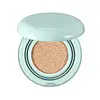Huda Beauty Easy Bake Loose Baking & Setting Powder Versus innisfree No-Sebum Powder Cushion SPF 29 PA++
What's inside
What's inside
 Key Ingredients
Key Ingredients

 Benefits
Benefits

No benefits
 Concerns
Concerns

 Ingredients Side-by-side
Ingredients Side-by-side

Talc
AbrasiveSynthetic Fluorphlogopite
Silica
AbrasiveDimethicone
EmollientNylon-12
Caprylyl Glycol
EmollientPentylene Glycol
Skin ConditioningOryza Sativa Starch
AbsorbentPhenyl Trimethicone
Skin ConditioningSodium Dehydroacetate
PreservativeOctyldodecyl Stearoyl Stearate
EmollientDiisostearyl Malate
EmollientParfum
MaskingTocopheryl Acetate
AntioxidantBenzyl Salicylate
PerfumingSorbitan Sesquioleate
EmulsifyingHexyl Cinnamal
PerfumingLinalool
PerfumingCoumarin
PerfumingHydroxycitronellal
PerfumingBenzyl Benzoate
AntimicrobialCI 77492
Cosmetic ColorantIron Oxides
Ultramarines
CI 19140
Cosmetic ColorantCI 77499
Cosmetic ColorantCI 73360
Cosmetic ColorantTalc, Synthetic Fluorphlogopite, Silica, Dimethicone, Nylon-12, Caprylyl Glycol, Pentylene Glycol, Oryza Sativa Starch, Phenyl Trimethicone, Sodium Dehydroacetate, Octyldodecyl Stearoyl Stearate, Diisostearyl Malate, Parfum, Tocopheryl Acetate, Benzyl Salicylate, Sorbitan Sesquioleate, Hexyl Cinnamal, Linalool, Coumarin, Hydroxycitronellal, Benzyl Benzoate, CI 77492, Iron Oxides, Ultramarines, CI 19140, CI 77499, CI 73360
Water
Skin ConditioningCI 77891
Cosmetic ColorantCyclopentasiloxane
EmollientButylene Glycol
HumectantMethyl Trimethicone
Skin ConditioningPentaerythrityl Tetraethylhexanoate
EmollientPEG-10 Dimethicone
Skin ConditioningCyclohexasiloxane
EmollientSilica
AbrasiveBoron Nitride
AbsorbentMica
Cosmetic ColorantLauryl Polyglyceryl-3 Polydimethylsiloxyethyl Dimethicone
Skin ConditioningDimethicone
EmollientTrimethylsiloxysilicate
EmollientDiisostearyl Malate
EmollientVinyl Dimethicone/Methicone Silsesquioxane Crosspolymer
CI 77492
Cosmetic ColorantPolymethyl Methacrylate
Disteardimonium Hectorite
StabilisingAcrylates/Ethylhexyl Acrylate/Dimethicone Methacrylate Copolymer
Skin ConditioningPolysilicone-11
Sodium Chloride
MaskingPanthenol
Skin ConditioningAlumina
AbrasiveAluminum Hydroxide
EmollientDimethicone/Vinyl Dimethicone Crosspolymer
Skin ConditioningTriethoxycaprylylsilane
CI 77491
Cosmetic ColorantCaprylyl Glycol
EmollientPolysorbate 80
EmulsifyingEthylhexylglycerin
Skin ConditioningGlyceryl Caprylate
EmollientHydrogenated Lecithin
EmulsifyingMethicone
EmollientCI 77499
Cosmetic ColorantDisodium EDTA
Propanediol
SolventPolymethylsilsesquioxane
Aluminum Starch Octenylsuccinate
Absorbent1,2-Hexanediol
Skin ConditioningTocopherol
AntioxidantCamellia Sinensis Leaf Extract
AntimicrobialWater, CI 77891, Cyclopentasiloxane, Butylene Glycol, Methyl Trimethicone, Pentaerythrityl Tetraethylhexanoate, PEG-10 Dimethicone, Cyclohexasiloxane, Silica, Boron Nitride, Mica, Lauryl Polyglyceryl-3 Polydimethylsiloxyethyl Dimethicone, Dimethicone, Trimethylsiloxysilicate, Diisostearyl Malate, Vinyl Dimethicone/Methicone Silsesquioxane Crosspolymer, CI 77492, Polymethyl Methacrylate, Disteardimonium Hectorite, Acrylates/Ethylhexyl Acrylate/Dimethicone Methacrylate Copolymer, Polysilicone-11, Sodium Chloride, Panthenol, Alumina, Aluminum Hydroxide, Dimethicone/Vinyl Dimethicone Crosspolymer, Triethoxycaprylylsilane, CI 77491, Caprylyl Glycol, Polysorbate 80, Ethylhexylglycerin, Glyceryl Caprylate, Hydrogenated Lecithin, Methicone, CI 77499, Disodium EDTA, Propanediol, Polymethylsilsesquioxane, Aluminum Starch Octenylsuccinate, 1,2-Hexanediol, Tocopherol, Camellia Sinensis Leaf Extract
 Reviews
Reviews

Ingredients Explained
These ingredients are found in both products.
Ingredients higher up in an ingredient list are typically present in a larger amount.
Caprylyl Glycol is a humectant and emollient, meaning it attracts and preserves moisture.
It is a common ingredient in many products, especially those designed to hydrate skin. The primary benefits are retaining moisture, skin softening, and promoting a healthy skin barrier.
Though Caprylyl Glycol is an alcohol derived from fatty acids, it is not the kind that can dry out skin.
This ingredient is also used as a preservative to extend the life of products. It has slight antimicrobial properties.
Learn more about Caprylyl GlycolCi 77492 is also hydrated iron III oxide. It's sole purpose is to give a yellow hue to products.
Iron III oxides are classified as inorganic chemicals for coloring.
Synthetically created Ci 77492 is considered safer than those naturally found. This is because the synthetically created version may contain less impurities. Iron oxides are generally non-toxic and non-allergenic.
Learn more about CI 77492Ci 77499 is also hydrated iron III oxide. It is created from mixing red and black iron oxides. This helps give shades of darkness to a product.
Iron III oxides are classified as inorganic chemicals for coloring.
Diisostearyl Malate is an emollient and most often used in lip products. It comes from isostearyl alcohol, a fatty acid, and malic acid, an AHA.
As an emollient, Diisostearyl Malate helps create a thin film on your skin to trap moisture in. This helps keep your skin soft and smooth.
Dimethicone is a type of synthetic silicone created from natural materials such as quartz.
What it does:
Dimethicone comes in different viscosities:
Depending on the viscosity, dimethicone has different properties.
Ingredients lists don't always show which type is used, so we recommend reaching out to the brand if you have questions about the viscosity.
This ingredient is unlikely to cause irritation because it does not get absorbed into skin. However, people with silicone allergies should be careful about using this ingredient.
Note: Dimethicone may contribute to pilling. This is because it is not oil or water soluble, so pilling may occur when layered with products. When mixed with heavy oils in a formula, the outcome is also quite greasy.
Learn more about DimethiconeSilica, also known as silicon dioxide, is a naturally occurring mineral. It is used as a fine, spherical, and porous powder in cosmetics.
Though it has exfoliant properties, the function of silica varies depending on the product.
The unique structure of silica enhances the spreadability and adds smoothness, making it a great texture enhancer.
It is also used as an active carrier, emulsifier, and mattifier due to its ability to absorb excess oil.
In some products, tiny microneedles called spicules are made from silica or hydrolyzed sponge. When you rub them in, they lightly polish away dead skin layers and enhance the penetration of active ingredients.
Learn more about Silica